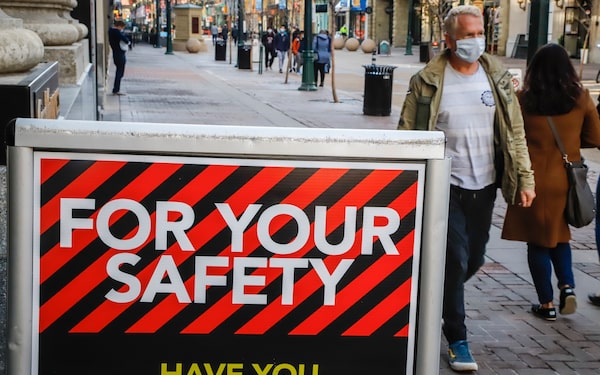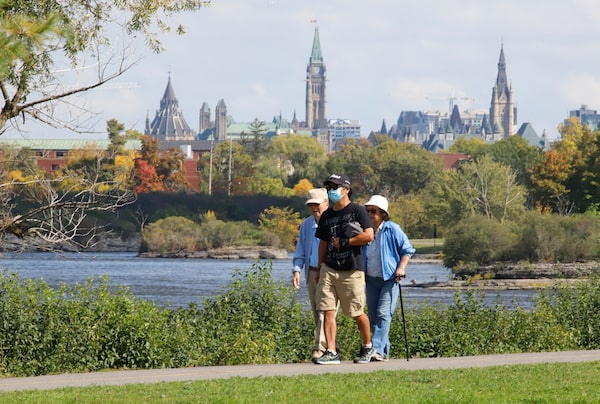
A man wears a mask in downtown Calgary on Oct. 30, 2020.Jeff McIntosh/The Canadian Press
Experts from around the world, including Canada’s Chief Public Health Officer Theresa Tam, have come to a consensus: Everyone should wear a mask when they are indoors in public places.
Quebec and Ontario made it mandatory in July and October, respectively, but Alberta, British Columbia and Saskatchewan are relying on moral suasion to convince their citizens to mask up to help curb the spread of COVID-19.
“Mandating masks is not something that is going to change people’s minds,” B.C.'s Provincial Health Officer Bonnie Henry told reporters at a pandemic briefing Thursday.
Quebec, Ontario weigh extending winter break at schools as COVID-19 cases surge
Told businesses are clamouring for her to upgrade her current “expectation” on mask usage and order the public to wear masks, Dr. Henry said stores should feel free to bar entry to anyone with an uncovered face. She said that option “is more enforceable than my telling people it’s an order you wear a mask.”
Case counts have exploded across the West and in Ontario and Quebec during the past few weeks. Some scientists credit the mandatory mask policy in Ontario and Quebec with ensuring transmission isn’t higher. But others – including Dr. Henry – argue that it won’t increase masking among the small minority that refuse to accept their strong advice or, for medical reasons, cannot don a face covering.
Dr. Tam, Canada’s top doctor, strongly advised people again Thursday to wear masks any time they are inside near someone with whom they are not living. In a statement, she said that an average of 50 people a day are now dying from the virus across the country.

A man wearing a mask rides his bicycle past a face mask mural in Toronto on Nov. 12, 2020.Nathan Denette/The Canadian Press
Earlier this week, the U.S. Centers for Disease Control and Prevention released new guidance recommending widespread use of masks as an effective tool to prevent asymptomatic people from spreading the virus to those nearby when they cough, sneeze, sing, talk, or breathe. Despite the lack of clinical research on face coverings, that federal body stated that seven studies from around the world have proven that when officials and political leaders issued directives for "universal masking, new infections fell significantly.
But Deena Hinshaw, Alberta’s Chief Medical Officer of Health, has argued it wouldn’t be effective for her to order masks to be worn in indoor public spaces. She has maintained that the differing levels of COVID-19 risk and transmission across different municipalities mean each city should consider its situation and pass mask rules as they see fit.
The province’s two most populous communities, Calgary and Edmonton, as well as some smaller ones such as Lethbridge, Okotoks, Airdrie, Grande Prairie, Fort McMurray, have done that with mask bylaws that require them in all indoor public spaces. Alberta Premier Jason Kenney has argued provincial rules are useless because his government can’t enforce its way out of the pandemic.
He said the province opted for a “very strong recommendation” for Albertans to wear masks or face shields in public, especially in crowded areas where physical distancing isn’t much of an option, citing mass transit as an example.

A young woman holds a sign that says 'Masks Save Lives' at a rally and march being held by protesters opposed to COVID-19 regulations, in Vancouver, on Oct. 18, 2020.DARRYL DYCK/The Canadian Press
That mirrors Saskatchewan Premier Scott Moe’s stance, as he has resisted calls from the NDP opposition and a petition from more than 400 doctors to make covering up compulsory in public parts of that province.
This light touch from those at the top is the wrong call, says Colin Furness, an infection control epidemiologist and assistant professor at the University of Toronto. Dr. Furness said mask mandates work to cut down on the rates of transmissions in cities. He attributed the continuing infection surges in Ontario and Quebec mostly to the weather changing. Colder weather keeps the virus from breaking down as quickly once droplets are exhaled and the drier air makes them lighter and able to float airborne longer, he explained.
Dr. Furness said a study from the IZA Institute of Labor Economics published in June proved the orders to wear masks work by comparing the effect making masks compulsory had on different regions, which rolled out these rules at different times. That statistical analysis found this measure reduced the cumulative number of COVID-19 cases between 2 per cent and 10 per cent in the 10 days after it was brought in. The researchers also concluded that mask mandates reduced the daily growth rate of reported infections by about 40 per cent.
Another more telling data point is the fact every known superspreader event has involved people without masks, Dr. Furness said.

Quebec and Ontario made it mandatory in July and October, respectively.PATRICK DOYLE/The Canadian Press
By strongly recommending mask usage but not mandating it, he argues, politicians and public-health leaders are polarizing communities by giving tacit permission to the small maskless minority “who are in denial and angry” to continue putting the rest of the population at risk with their actions
Caroline Colijn, an infectious disease modeller at Simon Fraser University, said there is a tendency for some people to liken mask mandates to a “magic button that will solve COVID-19.” She said studies show they can be both effective and make no difference, but the policy can seem attractive because it doesn’t require shutting down businesses or activities.
Dr. Colijn, the Canada 150 Research Chair in Mathematics for Evolution, Infection and Public Health, said mask uptake in B.C. is already quite high. If pressed, she said she would come out slightly in favour of a mask mandate, but added other measures such as mass testing, contact tracing and lockdowns are more effective.
As infections continue to rise in Alberta and B.C., doctors and municipal politicians say they will continue pushing their provincial governments to force people to cover their faces in public.
Sarah Kirby-Yung, a Vancouver city councillor, said she was disappointed when her motion to make masks mandatory in civic facilities was watered down last month to “strongly encourage” masking up, a lighter recommendation backed by the local medical health officer. Ms. Kirby-Yung said the province now needs to step up with a mandate to provide the clear and simple message that masks are helping in the fight against the coronavirus.
In Calgary, 90 per cent of people said they are wearing a face covering when they go to public spaces, compared with 34 per cent before the bylaw saying to do so was implemented on Aug.1, according to Barb Doyscher of Calgary community standards department.
Calgary emergency physician Joe Vipond said the substantial increase in the compliance rate in the city demonstrates the effectiveness of the policy.
He stressed that in order to curb the transmission rate of the pandemic, at least 80 per cent of the population need to wear a mask, and the only way to achieve that number is through mask mandates.
Tehseen Ladha, a pediatrician and associate professor at University of Alberta, agrees about the need for this strong and consistent message from her province. She said that the mix of municipal rules is complicating matters: "People who aren’t masking in other jurisdictions can come to cities that have mask mandates and bring things in.”
We have a weekly Western Canada newsletter written by our B.C. and Alberta bureau chiefs, providing a comprehensive package of the news you need to know about the region and its place in the issues facing Canada. Sign up today.
 Mike Hager
Mike Hager Xiao Xu
Xiao Xu